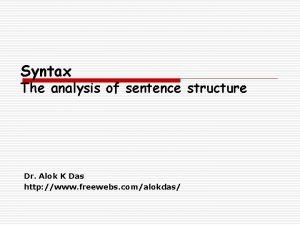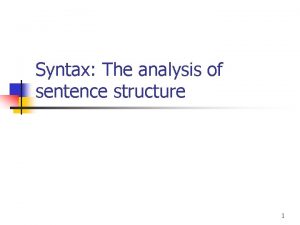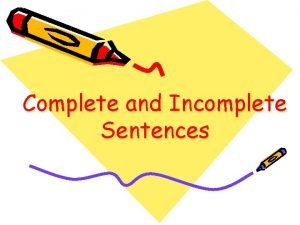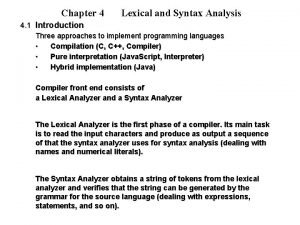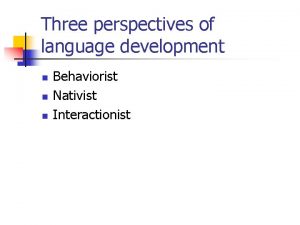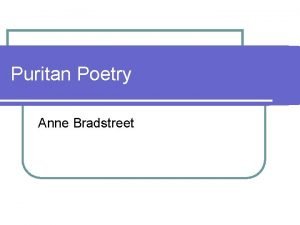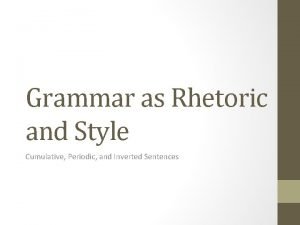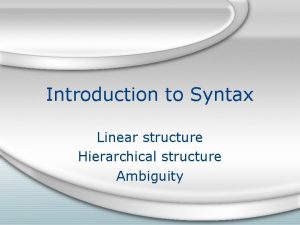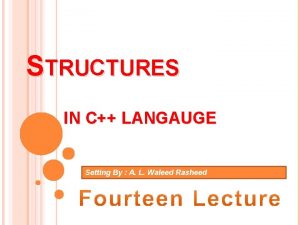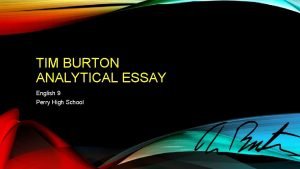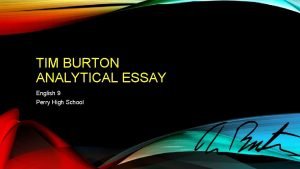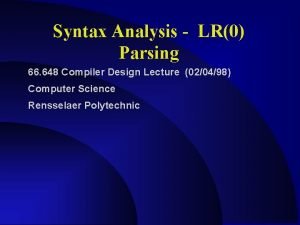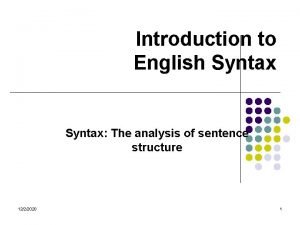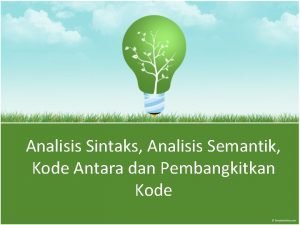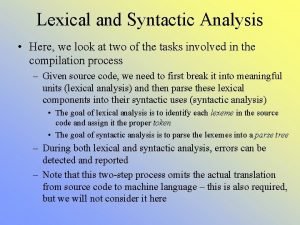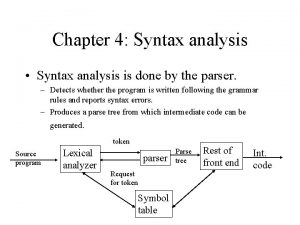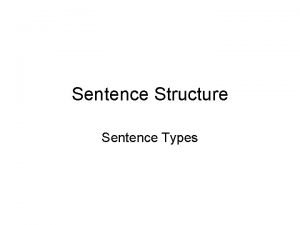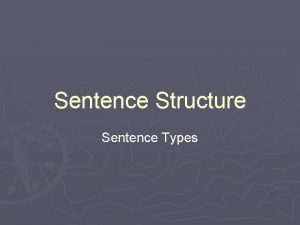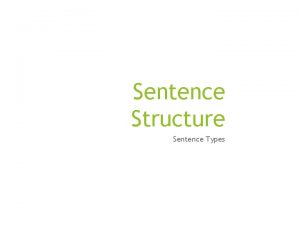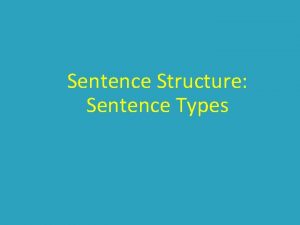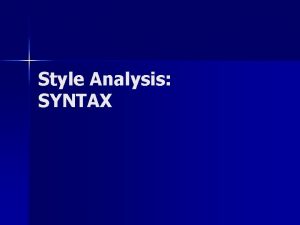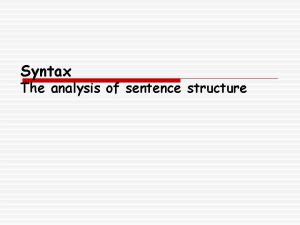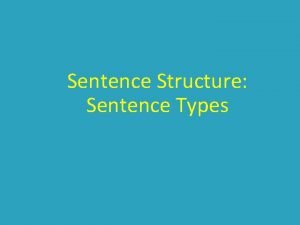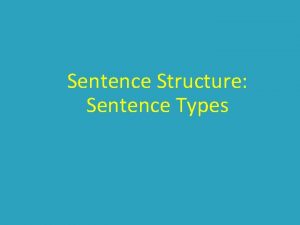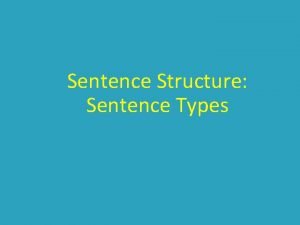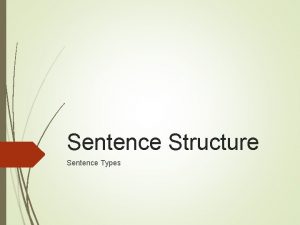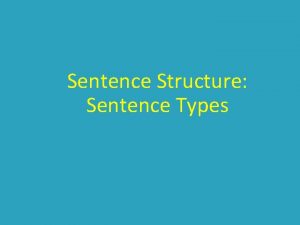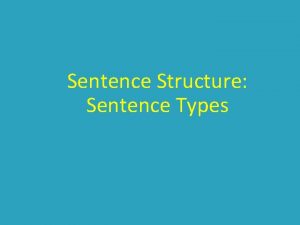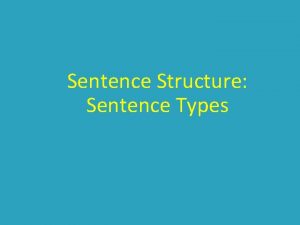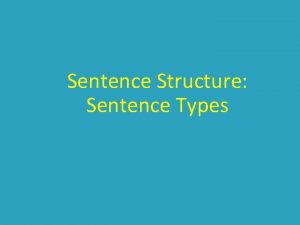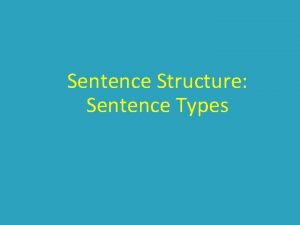SYNTAX Style Analysis Syntax Syntax sentence structure Syntax























- Slides: 23

SYNTAX Style Analysis

Syntax Syntax = sentence structure Syntax controls verbal pacing and focus. It is important to examine sentence patterns and variety for their effects. Syntax includes: 1) Sentence parts 2) Word order 3) Sentence length 4) Punctuation

Today’s Focus – Sentence Parts It is helpful to be able to identify different parts of the sentence. We will go over basic sentence vocabulary today.

1)Sentence Parts The Subject: is the part of the sentence which expresses what the sentence is about. It’s the topic of the sentence. The lion ran into the wilderness. Ask yourself, “What is the sentence about? ” This will tell you the subject of the sentence.

1) Sentence Parts The Verb (or predicate): is the part of the sentence that expresses action or connects the subject with the other words in the sentence. The lion ran into the wilderness. Ask yourself, “What does the lion do? ” or “ What is the sentence saying about the lion? ” That gives you the verb.

1) Sentence Parts A Clause: is a group of related words that has both a subject and a verb. The lion ran into the wilderness. A Phrase: is a group of related words that has no subject or verb. The lion ran into the wilderness.

1) Sentence Parts Sentence fragment: a group of words that is punctuated like a sentence but is not actually a sentence. It does not meet all the criteria of a sentence. Think of it as an incomplete thought. � UBC-O offers many majors in engineering. Such as electrical, chemical, and industrial engineering.

1) Sentence Parts Independent Clause: a clause that can stand alone; it has both a subject and a verb and is a complete thought. I love ice-cream. Chocolate cake is my favourite. English is a wonderfully intricate language.

1) Sentence Parts Subordinate Clause (or dependent clause): a clause that cannot stand alone; it is dependent on the rest of the sentence because it is an incomplete thought. �A subordinate clause starts with a subordinator word such as “when, ” “if” or “which. ” When Ronnie gets here, If Denise comes to class late,

Let’s Practice See handout.

Today’s Focus – The Rest We need to examine the rest the components that make up syntax.

2) Word Order Changing the word order can change the meaning of a sentence. � Jim said that he drives only a truck. (He drives nothing else) � Jim said that only he drives a truck. (No one else drives a truck) � Jim only said that he drives a truck. (He probably doesn’t really drive a truck) � Only Jim said that he drives a truck. (No one else said it)

3) Sentence Length Telegraphic – less than five words long Short – five words long Medium – approx. eighteen words long Long – greater than thirty words long

4) Punctuation Semi-colon: the semi-colon joins two or more clauses when there is no connecting word (and, but, or). When a semi-colon is used, all clauses are equally important, and the reader should pay equal attention to them all. � Ex. life. He is my best friend; I have known him most of my Colon: the colon tells the reader that something important will follow. � Ex. His is my best friend: he helps me through hard times and celebrates good times with me.

4) Punctuation Dash: the dash marks a sudden change in thought or sets off a summary. Parenthesis can do this, too, but the dash is more informal and conversational. � Ex. John – my best friend – lives right down the street. Italics: are used to talk about a word as a word (He used the word really too many times in that paragraph) or for emphasis. When we handwrite something, we show italics by

More Sophisticated Syntax Analysis Included on your sheet if you are interested. It is not necessary to know these terms!

What you should look for Focus on looking at the four key areas of syntax and answering the following questions: 1) Sentence parts � Devices: How would you describe the author’s use of the following: Independent and dependent clauses Repetition Parallelism Fragments Comparisons

What you should look for Word order � Structure: How are words and phrases arranged within the sentence? What is the author trying to accomplish through this arrangement? � Sentence beginnings: How does the author begin his or her sentences? (Does the author, for example, consistently begin with introductory phrases or clauses?

What you should look for Sentence length � Sentence length: How many words are in the different sentences? Do you notice any pattern (e. g. , a cluster of short sentences of a particular type)?

What you should look for Punctuation � Punctuation: How does the author punctuate the sentence and to what extent does the punctuation affect the meaning?

What you should look for Final Questions � Changes: Are there places where the syntax clearly changes? If so, where, how, and why? � Language: What use does the author make of figurative language or colloquial expressions?

Characterizing Syntax Just like you must provide an adjective when explaining tone, you must provide a description of the syntax in a text as well. Try to answer the following question: � How would you characterize the author’s syntax in this text? Options: � plain, sparse, unadorned � ornate, elaborate, flowery � jumbled, chaotic, -staccato, abrupt -elegant -musical, lyrical, lilting

Questions? Let’s practice!
 The magician touched the child with the wand structure tree
The magician touched the child with the wand structure tree The boy saw the man with the telescope
The boy saw the man with the telescope How to identify irrelevant sentences
How to identify irrelevant sentences Example of an incomplete sentence
Example of an incomplete sentence Lexical and syntax analysis
Lexical and syntax analysis Modified style
Modified style Formal and informal word
Formal and informal word What is informal writing style
What is informal writing style Referential style vs. expressive style
Referential style vs. expressive style Puritan poetry
Puritan poetry Periodic style vs running style
Periodic style vs running style Syntax of mkleaf is
Syntax of mkleaf is Belen masia
Belen masia Apa style structure
Apa style structure Hierarchical structure in syntax
Hierarchical structure in syntax C langauge
C langauge Figuarative language
Figuarative language Tim burton style analysis essay
Tim burton style analysis essay Corpse bride analysis essay
Corpse bride analysis essay Syntax analysis in compiler design
Syntax analysis in compiler design English syntax analyzer
English syntax analyzer Analisa sintaks
Analisa sintaks Lexical and syntax analysis
Lexical and syntax analysis Define syntax analysis
Define syntax analysis
